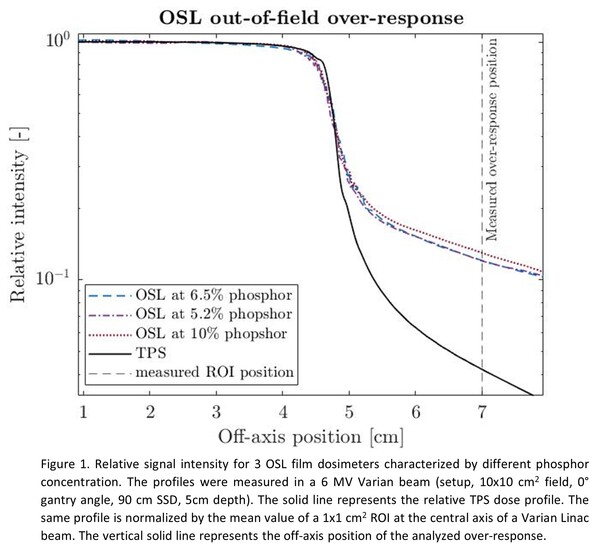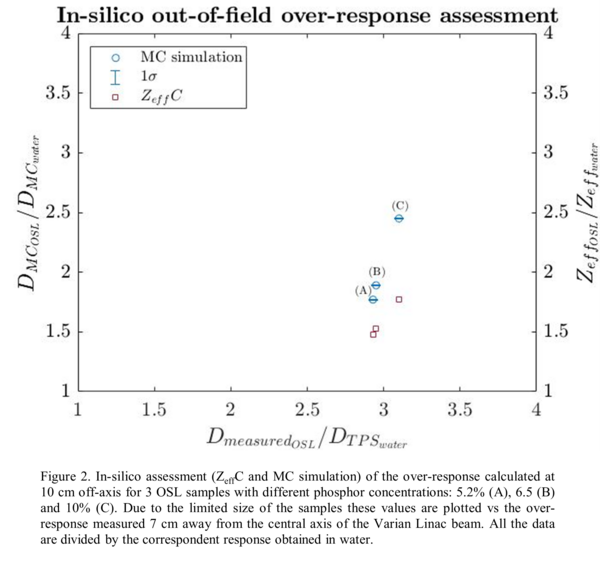In-silico assessment of the out-of-field over-response of an optically stimulated luminescent film
PO-1539
Abstract
In-silico assessment of the out-of-field over-response of an optically stimulated luminescent film
Authors: Marco Caprioli1, Marijke De Saint-Hubert2, Luana de Freitas Nascimento3, Laurence Delombaerde4, Shamil Samanta Galvez Febles5, Katleen Himschoot6, Dirk Vandenbroucke6, Paul Leblans6, Wouter Crijns7
1KU Leuven, Oncology, Leuven, Belgium; 2Belgian Nuclear Research Centre (SCK CEN), Research in Dosimetric Application, Mol, Belgium; 3Belgian Nuclear Research Centre (SCK CEN), Research in Dosimetric Application , Mol, Belgium; 4KU Leuven , Oncology, Leuven, Belgium; 5Università degli Studi di Milano, Fisica, Milano, Italy; 6Agfa N.V., Corporate Innovation Office, Mortsel, Belgium; 7University Hospital Leuven, Department of Radiation Oncology, Leuven, Belgium
Show Affiliations
Hide Affiliations
Purpose or Objective
The QUARTEL project aims to optimize 2D
Optically Stimulated Luminescent (OSL) film for pre-treatment radiotherapy
dosimetry. This dosimeter has an energy dependent signal resulting in a varying
response in function of position (in-field vs out-field), beam-modulation (static
beams vs IMRT), etc. This work investigates in-silico evaluation of the
out-of-field over-response to avoid measurements-based assessment using existing
analytical Z-effective calculations (ZeffC) and Monte Carlo (MC) dose
simulations.
Material and Methods
In the context of the QUARTEL project three OSL
films were produced utilizing a BaFBr:Eu2+ powder embedded in a
water equivalent polymer-based binder. Three samples with different weight concentration
were tested: 5,2% (A), 6.5% (B), 10% (C).
For the in-silico assessment, these phosphor films were first modeled as
homogeneous distributions of BaFBr:Eu2+. The OSL over-response
assessment uses (1) a
complete out of field energy spectrum (setup1: Varian 6MV, 10cm off-axis, 10x10
cm2 field, 0° gantry angle, 90 cm SSD, 5cm depth) and (2) two mono-energetic spectra representing
the in-field (1.25MeV) and out-of-field (0.115 MeV) situations for
both ZeffC and MC simulations (MCNP 6.2.). The over-response in setup 1) was measured in a
Varian Linac and considers the mean value of a 1x1 cm2 ROI at 7cm from
the central axis due to the limited size of the film. All the data (Zeff, dose) were divided by the corresponding response in water as
in (1) and (2).
Results
The measured over-response is consistent with the in-silico assessment (Figure
1 and 2), although the difference between samples A and B is comparable with the
standard deviation within the ROI: 0.0069. The calculated Zeff is 1.48
(A), 1.53 (B), and 1.77 (C) times higher than water. Similarly, for MC, the
simulated dose response increases with the phosphor (%) from 1.77 (A) to 2.45 (C)
with a precision of 0.29%. The in-silico results passing from the represented
in-field to the out-of-field regions (2) show an increased over-response at lower
energies (Table 1) up to 2.41 times for the MC simulated sample C.


Table 1. In-silico assessment of the OSL out-of-field over-response (R) in 2 monoenergetic beams representative for an out-of-field and in-field
photon energy spectrum.
| Phosphor concentration (%) | ROSL/RWater(115 KeV) | ROSL/RWater (1.25 MeV) |
| 5.2 (A) | 1.61(MC)/1.54(Zeff) | 0.91(MC)/1.15(Zeff)
|
| 6.5 (B) | 1.84(MC)/1.61(Zeff)
| 0.91(MC)/1.13(Zeff)
|
| 10 (C) | 2.17(MC)/2.00(Zeff)
| 0.90(MC)/1.20(Zeff)
|
Conclusion
The in-silico assessment of the out-of-field over-response shows a
correlation with the Z-effective calculation as well as the MC simulations.
Both methodologies can be utilized to evaluate the energy dependence for new
OSL material. The Z-effective could be used for a quick assessment, but MC can
cope with non-homogeneous layers as well (future work).
The out-of-field spectra were provided by the team of Prof. Dr. Stephen Kry of MD Anderson.
The Zeff calculator is produced by ML Taylor, et al., Med. Phys. 39 (2012) 1769-1778